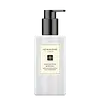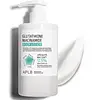What's inside
What's inside
 Key Ingredients
Key Ingredients

 Benefits
Benefits

 Concerns
Concerns

 Ingredients Side-by-side
Ingredients Side-by-side

Water
Skin ConditioningAloe Barbadensis Leaf Extract
EmollientCaprylic/Capric/Myristic/Stearic Triglyceride
EmollientButylene Glycol
HumectantHydrogenated Polyisobutene
EmollientPPG-5-Ceteth-20
EmulsifyingParfum
MaskingCetyl Acetate
EmollientCocos Nucifera Oil
MaskingPEG-40 Stearate
EmulsifyingGlyceryl Stearate
EmollientCrithmum Maritimum Extract
Skin ConditioningMaris Sal
Skin ConditioningDimethicone
EmollientSorbitan Stearate
EmulsifyingGlyceryl Laurate
EmollientJojoba Alcohol
EmollientIsopropyl Jojobate
EmollientJojoba Esters
EmollientCaprylyl Glycol
EmollientCaprylic/Capric Triglyceride
MaskingSodium Hyaluronate
HumectantHexylene Glycol
EmulsifyingCarbomer
Emulsion StabilisingTromethamine
BufferingBHT
AntioxidantDisodium EDTA
Butylphenyl Methylpropional
PerfumingCitral
PerfumingLimonene
PerfumingLinalool
PerfumingGeraniol
PerfumingCitronellol
PerfumingPhenoxyethanol
PreservativeWater, Aloe Barbadensis Leaf Extract, Caprylic/Capric/Myristic/Stearic Triglyceride, Butylene Glycol, Hydrogenated Polyisobutene, PPG-5-Ceteth-20, Parfum, Cetyl Acetate, Cocos Nucifera Oil, PEG-40 Stearate, Glyceryl Stearate, Crithmum Maritimum Extract, Maris Sal, Dimethicone, Sorbitan Stearate, Glyceryl Laurate, Jojoba Alcohol, Isopropyl Jojobate, Jojoba Esters, Caprylyl Glycol, Caprylic/Capric Triglyceride, Sodium Hyaluronate, Hexylene Glycol, Carbomer, Tromethamine, BHT, Disodium EDTA, Butylphenyl Methylpropional, Citral, Limonene, Linalool, Geraniol, Citronellol, Phenoxyethanol
Water
Skin ConditioningCentella Asiatica Extract 12.3%
CleansingGlycerin
HumectantCetyl Ethylhexanoate
EmollientCetearyl Alcohol
EmollientGlyceryl Stearate
EmollientGlutathione
Niacinamide
SmoothingMadecassic Acid
Skin ConditioningAsiaticoside
AntioxidantAsiatic Acid
Skin ConditioningSolanum Melongena Fruit Extract
Skin ConditioningMelaleuca Alternifolia Leaf Extract
PerfumingHydrolyzed Collagen
EmollientBeta-Glucan
Skin ConditioningHippophae Rhamnoides Fruit Extract
Skin ConditioningNelumbo Nucifera Extract
Skin ConditioningArtemisia Annua Extract
MaskingOryza Sativa Extract
AbsorbentSaccharomyces Ferment
Skin ConditioningSqualane
EmollientSodium Hyaluronate
HumectantDipropylene Glycol
HumectantButylene Glycol
HumectantHydrogenated Lecithin
EmulsifyingCholesterol
EmollientXanthan Gum
EmulsifyingPotassium Hydroxide
BufferingDisodium EDTA
Caprylic/Capric Triglyceride
MaskingCyclopentasiloxane
EmollientCyclohexasiloxane
EmollientSaccharide Hydrolysate
HumectantSorbitan Stearate
EmulsifyingDimethicone
EmollientPEG-100 Stearate
Stearic Acid
Cleansing1,2-Hexanediol
Skin ConditioningChlorphenesin
AntimicrobialCarbomer
Emulsion StabilisingCaprylyl Glycol
EmollientWater, Centella Asiatica Extract 12.3%, Glycerin, Cetyl Ethylhexanoate, Cetearyl Alcohol, Glyceryl Stearate, Glutathione, Niacinamide, Madecassic Acid, Asiaticoside, Asiatic Acid, Solanum Melongena Fruit Extract, Melaleuca Alternifolia Leaf Extract, Hydrolyzed Collagen, Beta-Glucan, Hippophae Rhamnoides Fruit Extract, Nelumbo Nucifera Extract, Artemisia Annua Extract, Oryza Sativa Extract, Saccharomyces Ferment, Squalane, Sodium Hyaluronate, Dipropylene Glycol, Butylene Glycol, Hydrogenated Lecithin, Cholesterol, Xanthan Gum, Potassium Hydroxide, Disodium EDTA, Caprylic/Capric Triglyceride, Cyclopentasiloxane, Cyclohexasiloxane, Saccharide Hydrolysate, Sorbitan Stearate, Dimethicone, PEG-100 Stearate, Stearic Acid, 1,2-Hexanediol, Chlorphenesin, Carbomer, Caprylyl Glycol
 Reviews
Reviews

Ingredients Explained
These ingredients are found in both products.
Ingredients higher up in an ingredient list are typically present in a larger amount.
Butylene Glycol (or BG) is used within cosmetic products for a few different reasons:
Overall, Butylene Glycol is a safe and well-rounded ingredient that works well with other ingredients.
Though this ingredient works well with most skin types, some people with sensitive skin may experience a reaction such as allergic rashes, closed comedones, or itchiness.
Learn more about Butylene GlycolThis ingredient is an emollient, solvent, and texture enhancer. It is considered a skin-softener by helping the skin prevent moisture loss.
It helps thicken a product's formula and makes it easier to spread by dissolving clumping compounds.
Caprylic Triglyceride is made by combining glycerin with coconut oil, forming a clear liquid.
While there is an assumption Caprylic Triglyceride can clog pores due to it being derived from coconut oil, there is no research supporting this.
Learn more about Caprylic/Capric TriglycerideCaprylyl Glycol is a humectant and emollient, meaning it attracts and preserves moisture.
It is a common ingredient in many products, especially those designed to hydrate skin. The primary benefits are retaining moisture, skin softening, and promoting a healthy skin barrier.
Though Caprylyl Glycol is an alcohol derived from fatty acids, it is not the kind that can dry out skin.
This ingredient is also used as a preservative to extend the life of products. It has slight antimicrobial properties.
Learn more about Caprylyl GlycolCarbomer is a polymer of acrylic acid. Its main role is to create a gel consistency.
A high amount of carbomer can cause pilling or balling up of products. Don't worry, most products contain 1% or less of carbomer.
Dimethicone is a type of synthetic silicone created from natural materials such as quartz.
What it does:
Dimethicone comes in different viscosities:
Depending on the viscosity, dimethicone has different properties.
Ingredients lists don't always show which type is used, so we recommend reaching out to the brand if you have questions about the viscosity.
This ingredient is unlikely to cause irritation because it does not get absorbed into skin. However, people with silicone allergies should be careful about using this ingredient.
Note: Dimethicone may contribute to pilling. This is because it is not oil or water soluble, so pilling may occur when layered with products. When mixed with heavy oils in a formula, the outcome is also quite greasy.
Learn more about DimethiconeDisodium EDTA plays a role in making products more stable by aiding other preservatives.
It is a chelating agent, meaning it neutralizes metal ions that may be found in a product.
Disodium EDTA is a salt of edetic acid and is found to be safe in cosmetic ingredients.
Learn more about Disodium EDTAGlyceryl Stearate is a mix of glycerin and stearic acid.
It is used to stabilize the mixing of water and oil ingredients. By preventing these ingredients from separating, it can help elongate shelf life. It can also help thicken the product's texture.
As an emollient, it helps soften skin and supports barrier-replenishing ingredients.
In cosmetics, Glyceryl Stearate is often made from vegetable oils or synthetically produced.
This ingredient may not be fungal-acne safe
Fun fact: The human body also creates Glyceryl Stearate naturally.
Learn more about Glyceryl StearateSodium Hyaluronate is hyaluronic acid's salt form. It is commonly derived from the sodium salt of hyaluronic acid.
Like hyaluronic acid, it is great at holding water and acts as a humectant. This makes it a great skin hydrating ingredient.
Sodium Hyaluronate is naturally occurring in our bodies and is mostly found in eye fluid and joints.
These are some other common types of Hyaluronic Acid:
Learn more about Sodium HyaluronateSorbitan Stearate comes from sorbitol and stearic acid. Sorbitol is a type of sugar and stearic acid is a fatty acid.
It is used as an emulsifier and helps ingredients stay together by creating water-in-oil emulsions.
This ingredient may not be Malassezia folliculitis, or fungal-acne safe.
Water. It's the most common cosmetic ingredient of all. You'll usually see it at the top of ingredient lists, meaning that it makes up the largest part of the product.
So why is it so popular? Water most often acts as a solvent - this means that it helps dissolve other ingredients into the formulation.
You'll also recognize water as that liquid we all need to stay alive. If you see this, drink a glass of water. Stay hydrated!
Learn more about Water